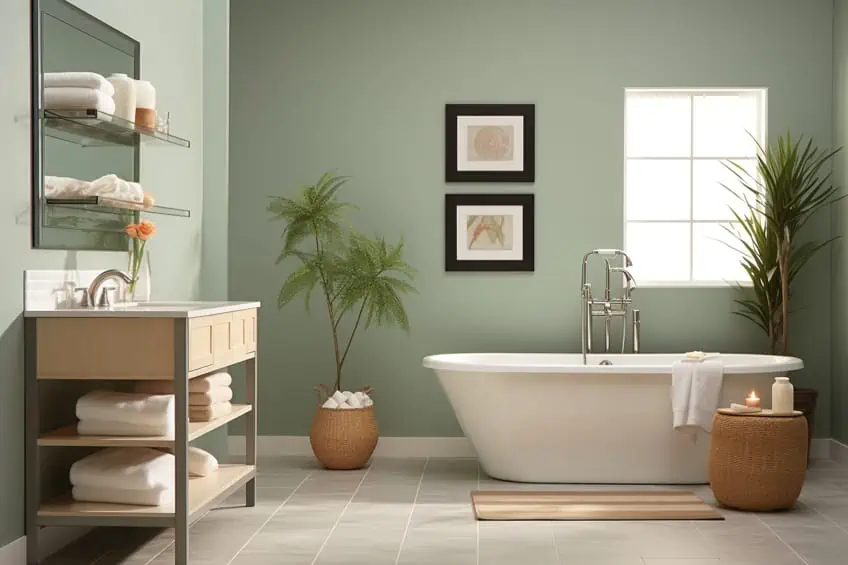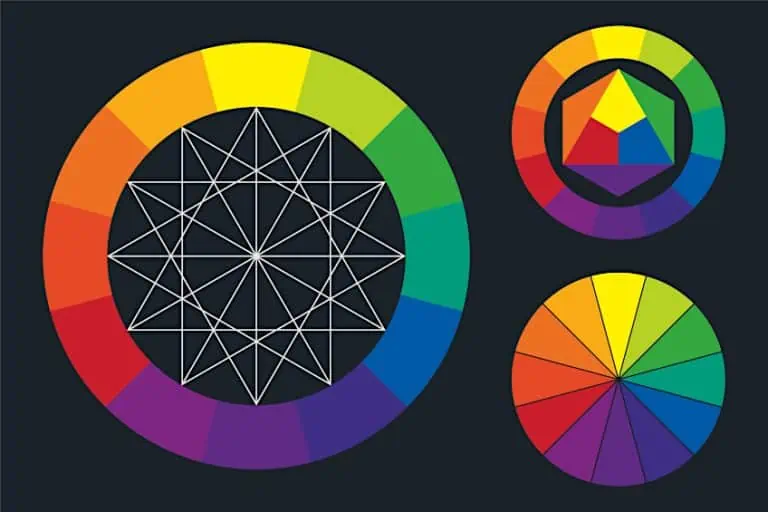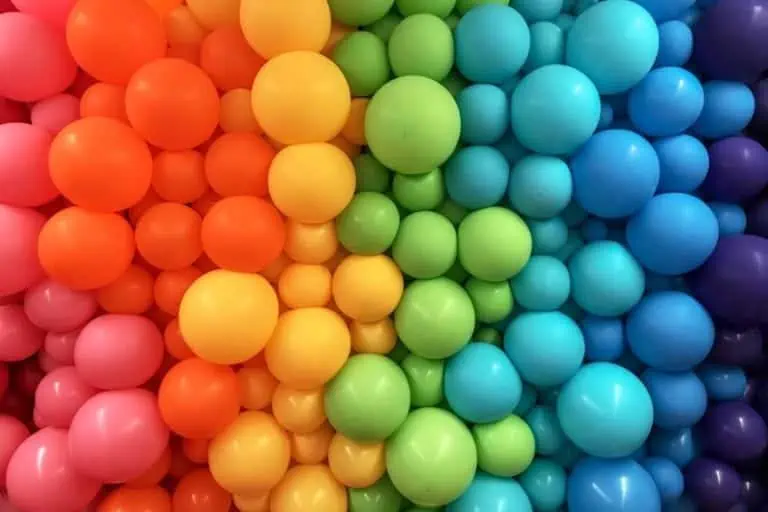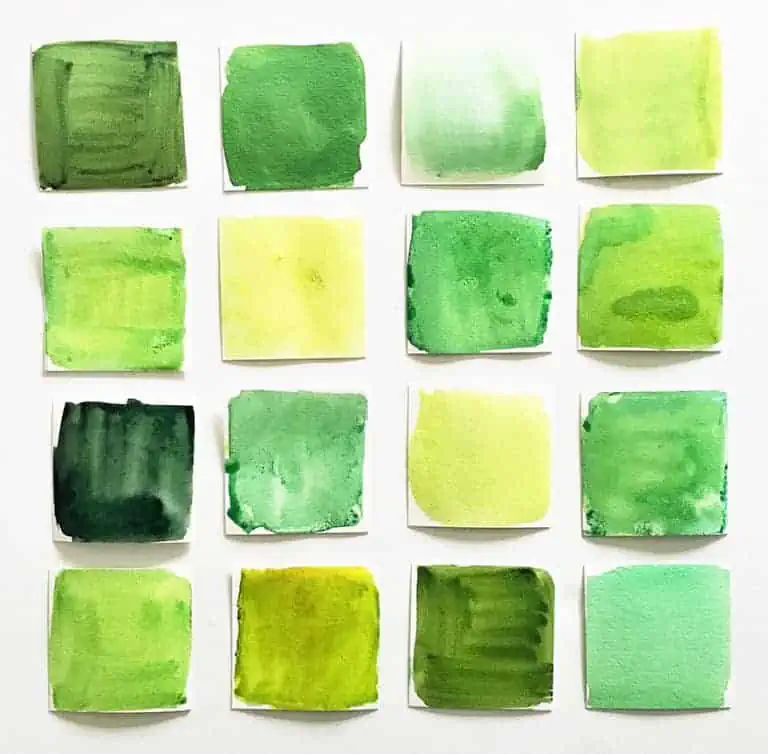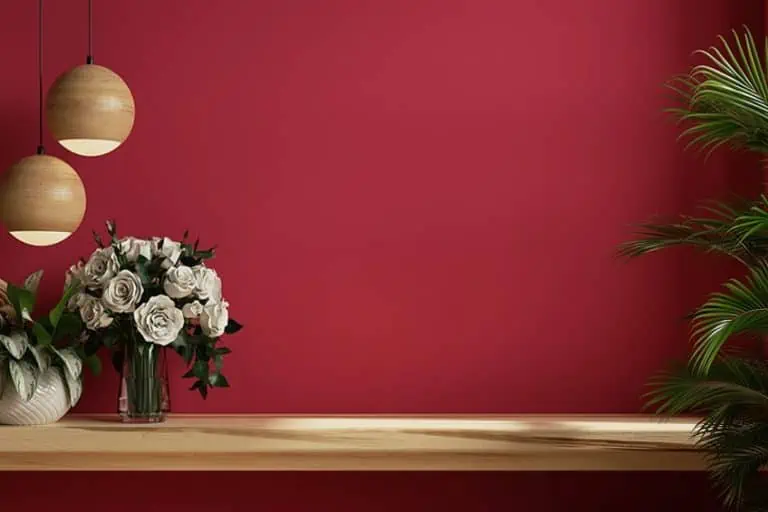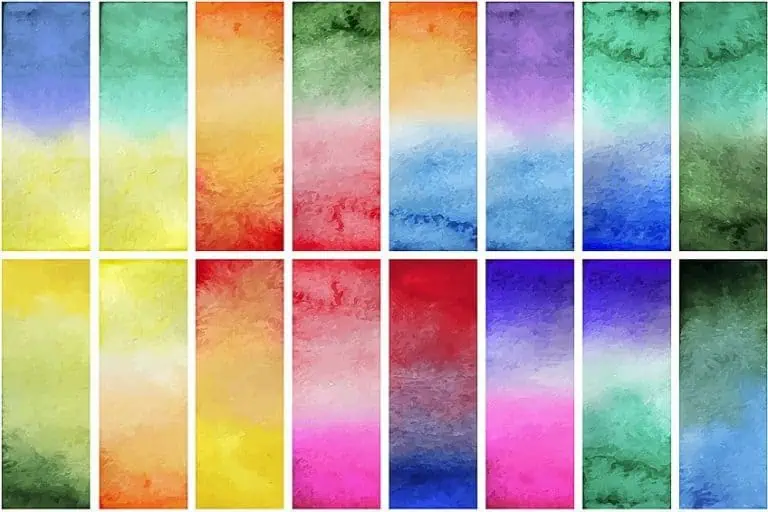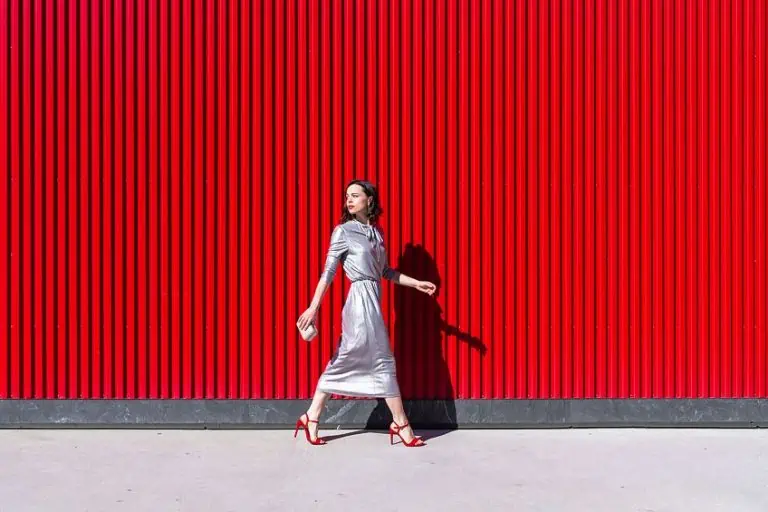What Colors Go With Sage Green? – 25 Chic Color Combinations
This post may contain affiliate links. We may earn a small commission from purchases made through them, at no additional cost to you.
Wondering what colors go with sage green? Being the color of the year for 2022, you have most likely seen sage green all over social media, as well as in the most popular interior design magazines. These high-quality images might have enticed you to buy this paint color, and now you are sitting with the predicament of not knowing what to pair the color with after you have used it on all your kitchen cupboards. Throughout the article, we will be looking at the different shades of sage green, as well as 25 perfect color combinations for each of them when it comes to design.
Table of Contents
- 1 Different Shades of Sage Green
- 1.1 Sage Green and Orange
- 1.2 Sage Green and Black
- 1.3 Sage Green and Purple
- 1.4 Sage Green and Pink
- 1.5 Sage Green and Yellow
- 1.6 Sage Green and Blue
- 1.7 Sage Green and Green
- 1.8 Sage Green and Gray
- 1.9 Sage Green and Mocha Brown
- 1.10 Sage Green and Creamy Ivory
- 1.11 Sage Green and Charcoal Gray
- 1.12 Sage Green and Terracotta
- 1.13 Sage Green and Dusty Rose
- 1.14 Sage Green and Slate Blue
- 1.15 Sage Green and Mustard Yellow
- 1.16 Sage Green and Plum Purple
- 1.17 Sage Green and Deep Burgundy
- 1.18 Sage Green and Earthy Taupe
- 1.19 Sage Green and Teal
- 1.20 Sage Green and Olive Green
- 1.21 Sage Green and Coral
- 1.22 Sage Green and Lavender
- 1.23 Sage Green and Copper Brown
- 1.24 Sage Green and Gold
- 1.25 Sage Green and Soft Gray
- 2 Frequently Asked Questions
Different Shades of Sage Green
Sage green is a very subjective color, as all people perceive color differently, and the intensity of sage green differs on the sage herb itself depending on various natural factors. There are many different shades, hues, and variables of sage green. Some sage greens are more cool-toned or warm-toned, and some are more vibrant than others.
This fact also makes sage green a very versatile color, and you can easily find a color combination to make work in almost any interior design setting.
We will be taking a look at the exact shades of sage green that match well with certain colors. Note that most of these shades should pair well with the colors below, however, the illustrated sage green shades are the ones that work best.
| Sage Green Shade | Hex Code | CMYK Color Code (%) | RGB Color Code | Color |
| Pure Sage Green | #B2AC88 | 0, 3, 24, 30 | 178, 172, 136 | |
| Sage Green #1 | #8ABD91 | 27, 0, 23, 26 | 138, 189, 145 | |
| Sage Green #2 | #9AC791 | 23, 0, 27, 22 | 154, 199, 145 | |
| Sage Green #3 | #C0C791 | 4, 0, 27, 27 | 192, 199, 145 | |
| Sage Green #4 | #A9BD93 | 11, 0, 22, 26 | 169, 189, 147 | |
| Sage Green #5 | #9CAF88 | 11, 0, 22, 31 | 156, 175, 136 | |
| Sage Green #6 | #779D84 | 24, 0, 16, 38 | 119, 157, 132 |

Sage Green and Orange
Combining two natural colors like sage green and terracotta orange is a great recipe for injecting interest and color into a space without going overboard with bright, rainbow-themed colors. These colors works well when terra cotta is naturally incorporated into the flooring.
You can use it in possibly the tiles, and sage green as the wall colors or furniture pieces.
| Shade | Hex Code | CMYK Color Code (%) | RGB Color Code | Color |
| Sage Green #4 | #A9BD93 | 11, 0, 22, 26 | 169, 189, 147 | |
| Terracotta Orange | #A24A0E | 0, 54, 91, 36 | 162, 74, 14 |

Sage Green and Black
Sage green and black are the perfect color combination when wanting to create a space that looks effortless and natural, yet contemporary. Incorporate sage green as the main color via wall colors or furniture pieces and make use of black in secondary furniture pieces, trimmings, and décor items.
| Shade | Hex Code | CMYK Color Code (%) | RGB Color Code | Color |
| Pure Sage Green | #B2AC88 | 0, 3, 24, 30 | 178, 172, 136 | |
| Black | #000000 | 0, 0, 0, 100 | 0, 0, 0 |

Sage Green and Purple
Nothing makes a statement than incorporating purple in an interior, and what better way to combine sage green than with its complementary color? Combining the growth and peace of sage green with the richness and wisdom of purple makes it the perfect combination for a study or a living room.
Keep in mind that these are two very vibrant colors, which means that it would be a good idea to introduce a neutral buffer color such as white, to balance out the interior.
| Shade | Hex Code | CMYK Color Code (%) | RGB Color Code | Color |
| Sage Green #2 | #9AC791 | 23, 0, 27, 22 | 154, 199, 145 | |
| Lavender | #BF9FF9 | 23, 36, 0, 2 | 191, 159, 249 |

Sage Green and Pink
Pink and sage green is a popular soft combination and a color pallet that can regularly be seen at weddings. Be sure to make use of a dusty pink instead of a bright, highly saturated, and pure pink, as dusty pink fits in better with the earthy tones of sage green. This color combination works particularly well when it comes to the design of bedrooms.
| Shade | Hex Code | CMYK Color Code (%) | RGB Color Code | Color |
| Sage Green #4 | #A9BD93 | 11, 0, 22, 26 | 169, 189, 147 | |
| Dusty Pink | #FFCCCC | 255, 204, 204 | 0, 20, 20, 0 |

Sage Green and Yellow
If you want to brighten up a sage green color pallet, mustard is the perfect color combination, especially considering that yellow is a monochromatic color of sage green. In this scenario, make use of sage green as your neutral color by applying it to the walls, floors, or large furniture pieces. Minimally incorporate mustard through one or two statement furniture pieces.
Adding a few brass décor pieces here will pick up on the mustard yellow and tie everything together.
| Shade | Hex Code | CMYK Color Code (%) | RGB Color Code | Color |
| Sage Green #4 | #A9BD93 | 11, 0, 22, 26 | 169, 189, 147 | |
| Mustard | #EEB000 | 0, 26, 100, 7 | 238, 176, 0 |

Sage Green and Blue
Navy blue might not be a color that people are naturally inclined to pair with sage green. However, this color paired with a cool-toned sage green makes for a beautiful and unique color combination. Make use of sage green as your base color, and add navy blue furniture pieces, décor, and decorative textiles and patterns. Inverse these colors by making use of navy blue as your base color to create a very dramatic interior.
| Shade | Hex Code | CMYK Color Code (%) | RGB Color Code | Color |
| Sage Green #6 | #779D84 | 24, 0, 16, 38 | 119, 157, 132 | |
| Navy Blue | #002060 | 100, 67, 0, 62 | 0, 32, 96 |
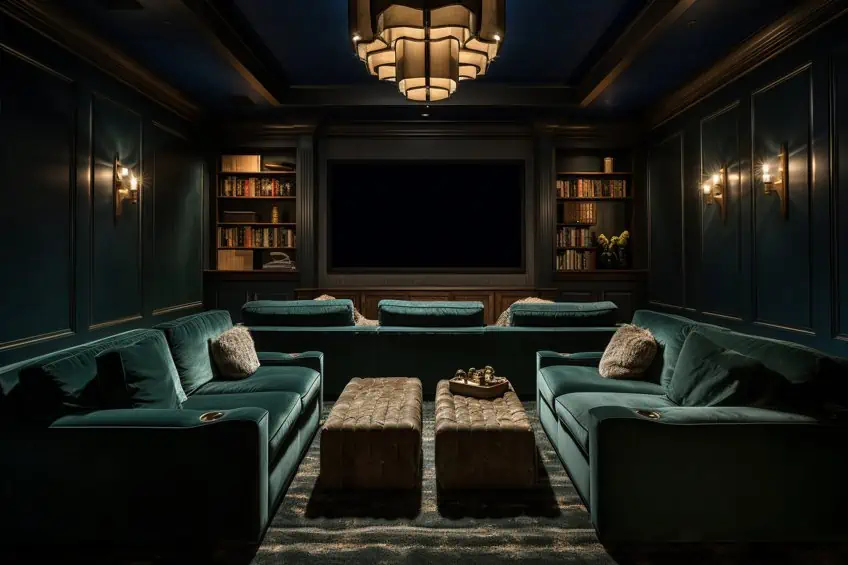
Sage Green and Green
When in doubt about what two colors go together, pair the exact two colors in different shades. Forest green adds a lot of natural depth to an interior when combined with sage green.
Make use of sage green on your walls and add forest green, and velvety soft furnishings throughout your interior to make the sage green stand out even more.
| Shade | Hex Code | CMYK Color Code (%) | RGB Color Code | Color |
| Pure Sage Green | #B2AC88 | 0, 3, 24, 30 | 178, 172, 136 | |
| Forest Green | #275333 | 53, 0, 39, 67 | 39, 83, 51 |

Sage Green and Gray
Does sage green go with gray? Gray and sage green work well together in an interior setting with the undertones of both colors taken into consideration. When working with a vibrant, cool-toned sage green, opt for a cool gray pairing. Make use of gray as the base color for the interior on the walls and floor and incorporate sage green in the soft furnishings and with other greenery.
| Shade | Hex Code | CMYK Color Code (%) | RGB Color Code | Color |
| Sage Green #6 | #779D84 | 24, 0, 16, 38 | 119, 157, 132 | |
| Cool Gray | #82828A | 6, 6, 0, 46 | 130, 130, 138 |

Sage Green and Mocha Brown
The combination of sage green and mocha brown creates a warm and earthy palette. The calming nature of Sage Green complements the richness of Mocha Brown, providing a balanced and inviting atmosphere. In interior design, consider using Sage Green as the dominant color for walls and larger furniture pieces, while incorporating Mocha Brown in accent furniture, decor, and textiles. This combination is excellent for creating a cozy and sophisticated ambiance in living rooms and bedrooms. Add throw pillows, rugs, and artwork that blend the two colors seamlessly to tie the space together.
| Shade | Hex Code | CMYK Color Code (%) | RGB Color Code | Color |
| Sage Green | #7BA05B | 37, 6, 58, 0 | 123, 160, 91 | |
| Mocha Brown | #6F4E37 | 35, 49, 66, 22 | 111, 78, 55 |
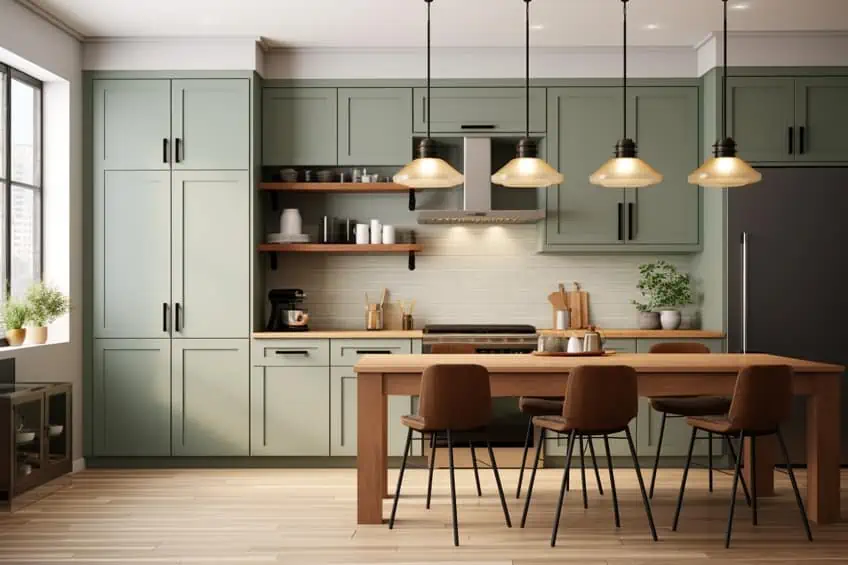
Sage Green and Creamy Ivory
Sage green paired with creamy ivory produces a soft and elegant color scheme. This combination is perfect for creating a serene and timeless interior. To implement this palette, use Sage Green for larger surfaces like walls or furniture and introduce Creamy Ivory through trim, upholstery, and accessories. This pairing works well in bedrooms, bathrooms, and other spaces where a light and airy feel is desired. Consider incorporating natural textures and materials, such as wooden furniture or linen fabrics, to enhance the organic harmony of these colors.
| Shade | Hex Code | CMYK Color Code (%) | RGB Color Code | Color |
| Sage Green | #7BA05B | 37, 6, 58, 0 | 123, 160, 91 | |
| Creamy Ivory | #FFF8E1 | 0, 1, 12, 0 | 255, 248, 225 |

Sage Green and Charcoal Gray
Sage green and charcoal gray offer a sophisticated and modern color combination. The muted tones of Sage Green balance well with the depth of Charcoal Gray, creating a contemporary and calming atmosphere. Use Sage Green as the main color for walls and larger elements, while Charcoal Gray can be introduced through furniture, accent walls, and textiles. Personal tip: Include metallic accents like silver or chrome to add a touch of glamour and elevate the overall aesthetic. This combination is particularly effective in living rooms and home offices.
| Shade | Hex Code | CMYK Color Code (%) | RGB Color Code | Color |
| Sage Green | #7BA05B | 37, 6, 58, 0 | 123, 160, 91 | |
| Charcoal Gray | #36454F | 68, 45, 39, 61 | 54, 69, 79 |

Sage Green and Terracotta
Pairing sage green with terracotta results in a warm and inviting palette that brings a touch of nature indoors. Consider using Sage Green as a base color for walls and larger furniture, and introduce Terracotta through accent pieces like throw pillows, vases, and artwork. This combination is ideal for creating a cozy and welcoming atmosphere in spaces like living rooms and dining areas. Personal tip: Incorporate indoor plants with lush greenery to enhance the natural vibe and complete the harmonious look.
| Shade | Hex Code | CMYK Color Code (%) | RGB Color Code | Color |
| Sage Green | #7BA05B | 37, 6, 58, 0 | 123, 160, 91 | |
| Terracotta | #E2725B | 0, 58, 49, 10 | 226, 114, 91 |

Sage Green and Dusty Rose
The combination of sage green and dusty rose creates a soft and romantic atmosphere. Sage Green provides a neutral backdrop, while Dusty Rose adds a hint of warmth and femininity. In bedrooms or sitting areas, use Sage Green for walls and larger furniture items, and introduce Dusty Rose through bedding, curtains, and decorative accents. Personal tip: Opt for vintage-inspired furniture pieces and soft lighting to enhance the romantic feel of the space. These colors are perfect for those who want a subtle and charming aesthetic in their home.
| Shade | Hex Code | CMYK Color Code (%) | RGB Color Code | Color |
| Sage Green | #7BA05B | 37, 6, 58, 0 | 123, 160, 91 | |
| Dusty Rose | #C7A9A3 | 0, 21, 19, 23 | 199, 169, 163 |

Sage Green and Slate Blue
Sage green and slate blue create a calming and sophisticated color scheme reminiscent of nature. This combination is versatile and works well in various rooms. Consider using Sage Green as a dominant color for walls and furniture, and introduce Slate Blue through accent pieces like throw blankets, artwork, and decorative accessories. Personal tip: Play with different textures, such as a plush rug or velvet upholstery, to add depth and interest to the space. This pairing is excellent for creating a serene and timeless atmosphere in bedrooms or living rooms.
| Shade | Hex Code | CMYK Color Code (%) | RGB Color Code | Color |
| Sage Green | #7BA05B | 37, 6, 58, 0 | 123, 160, 91 | |
| Slate Blue | #6A5ACD | 57, 53, 0, 19 | 106, 90, 205 |
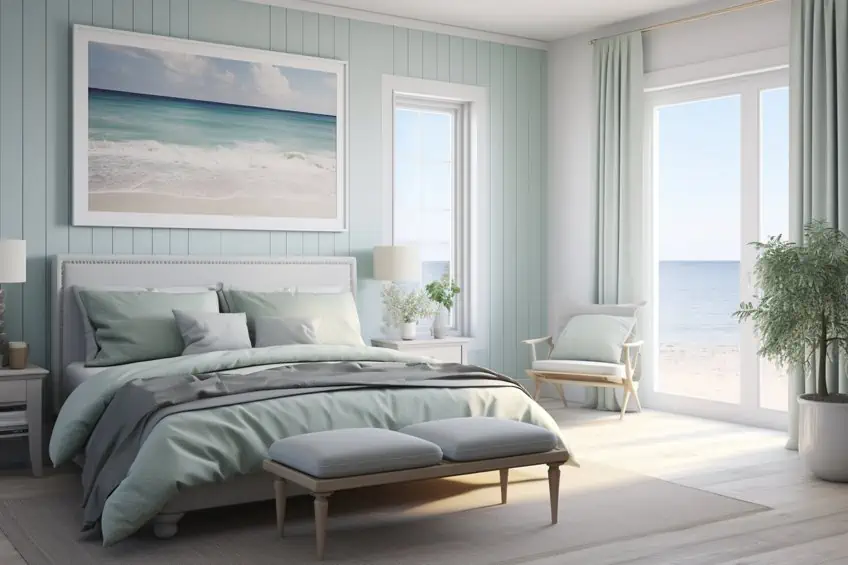
Sage Green and Mustard Yellow
The combination of sage green and mustard yellow injects a lively and energetic vibe into interior spaces. Sage Green can be used as the primary color for walls or larger furniture, while Mustard Yellow adds vibrant pops of color through accessories like pillows, rugs, and artwork. Personal tip: Balance the boldness of Mustard Yellow with neutral tones to create a visually appealing and harmonious space. This color combination is perfect for those who want to infuse their home with a sense of playfulness and optimism, making it well-suited for kitchens, dining areas, or home offices.
| Shade | Hex Code | CMYK Color Code (%) | RGB Color Code | Color |
| Sage Green | #7BA05B | 37, 6, 58, 0 | 123, 160, 91 | |
| Mustard Yellow | #FFDB58 | 0, 6, 64, 0 | 255, 219, 88 |
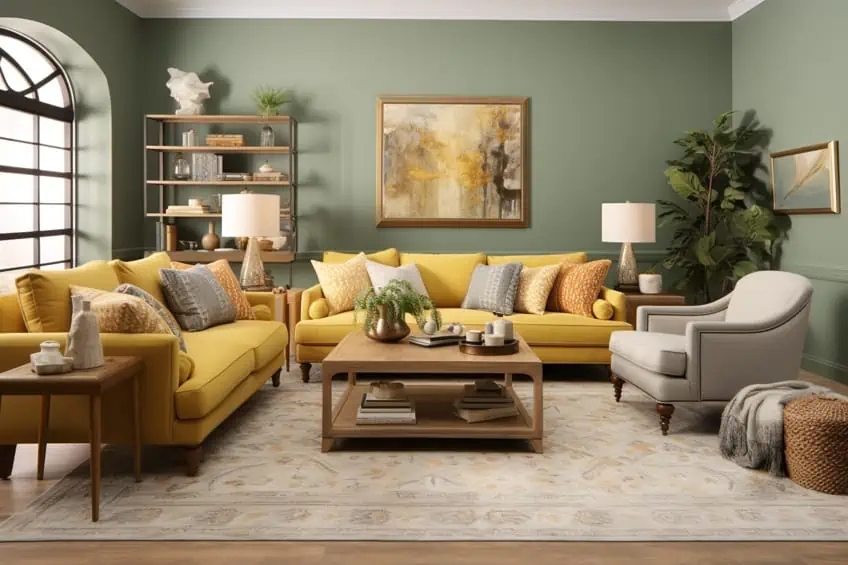
Sage Green and Plum Purple
Sage green paired with plum purple creates a rich and luxurious color scheme. Use Sage Green as the foundational color for walls or larger pieces of furniture and incorporate Plum Purple through accessories, accent walls, or upholstery. Personal tip: Introduce metallic elements like gold or brass to add a touch of glamour and elevate the overall elegance of the space. This combination is particularly well-suited for creating a sophisticated and opulent atmosphere in bedrooms or formal dining areas.
| Shade | Hex Code | CMYK Color Code (%) | RGB Color Code | Color |
| Sage Green | #7BA05B | 37, 6, 58, 0 | 123, 160, 91 | |
| Plum Purple | #8E4585 | 32, 70, 0, 47 | 142, 69, 133 |

Sage Green and Deep Burgundy
Sage green combined with deep burgundy results in a warm and inviting color palette with a touch of drama. Use Sage Green as the base color for walls and larger furnishings, and introduce Deep Burgundy through accent pieces like curtains, throw pillows, and artwork. Personal tip: Incorporate natural materials like wood and leather to add warmth and balance to the deep tones. This combination is perfect for creating a cozy and stylish ambiance in living rooms or home libraries.
| Shade | Hex Code | CMYK Color Code (%) | RGB Color Code | Color |
| Sage Green | #7BA05B | 37, 6, 58, 0 | 123, 160, 91 | |
| Deep Burgundy | #800020 | 0, 100, 75, 69 | 128, 0, 32 |
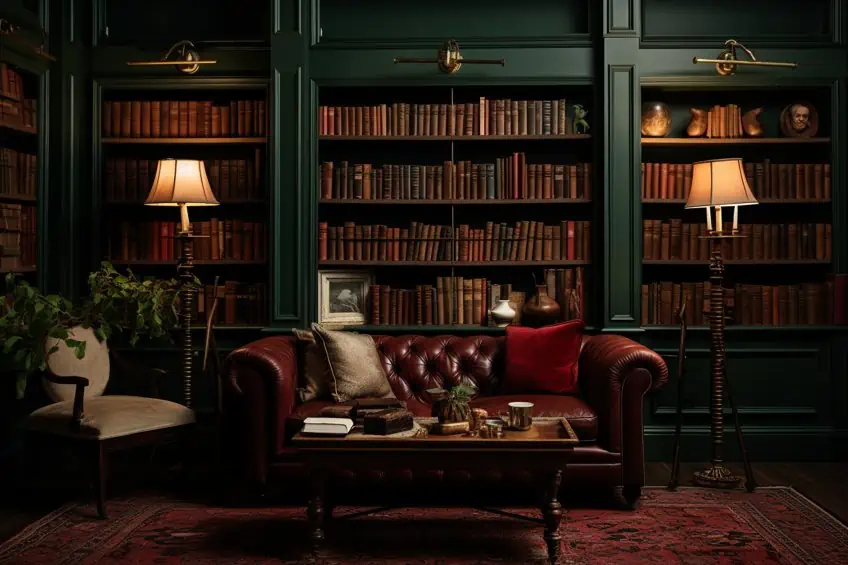
Sage Green and Earthy Taupe
Pairing sage green with earthy taupe creates a calm and neutral color scheme. Use Sage Green for larger surfaces like walls or furniture and incorporate Earthy Taupe through textiles, rugs, and decor items. Personal tip: Enhance the tranquility of the space by introducing natural elements such as stone or wood. This combination is ideal for those who prefer a timeless and understated look in their home, making it suitable for bedrooms, bathrooms, or any space where relaxation is a priority.
| Shade | Hex Code | CMYK Color Code (%) | RGB Color Code | Color |
| Sage Green | #7BA05B | 37, 6, 58, 0 | 123, 160, 91 | |
| Earthy Taupe | #7D5E3C | 32, 39, 63, 23 | 125, 94, 60 |

Sage Green and Teal
Sage green combined with teal creates a refreshing and vibrant color scheme that brings a sense of energy and balance to a space. Consider using Sage Green as a base color for walls or larger furniture and introduce Teal through accent pieces like throw pillows, rugs, and artwork. Personal tip: Incorporate natural light and mirrors to enhance the brightness and openness of the space. This combination is great for living rooms or home offices where you want to infuse a lively and dynamic atmosphere.
| Shade | Hex Code | CMYK Color Code (%) | RGB Color Code | Color |
| Sage Green | #7BA05B | 37, 6, 58, 0 | 123, 160, 91 | |
| Teal | #008080 | 100, 0, 33, 50 | 0, 128, 128 |
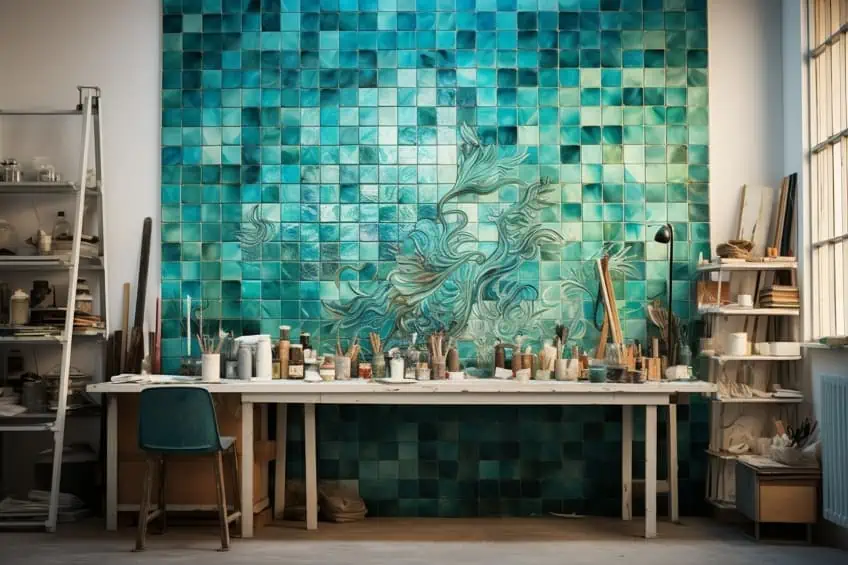
Sage Green and Olive Green
Pairing sage green with olive green creates a harmonious and nature-inspired color palette. Use Sage Green as the dominant color for walls or larger elements and introduce Olive Green through furniture, decor, and textiles. Personal tip: Incorporate wooden elements and earthy textures to enhance the organic feel of the space. This combination is ideal for creating a calming and grounded ambiance in bedrooms or living areas, providing a connection to the outdoors.
| Shade | Hex Code | CMYK Color Code (%) | RGB Color Code | Color |
| Sage Green | #7BA05B | 37, 6, 58, 0 | 123, 160, 91 | |
| Olive Green | #808000 | 49, 0, 100, 50 | 128, 128, 0 |

Sage Green and Coral
Sage green paired with coral creates a vibrant and playful color scheme that is perfect for injecting energy into a space. Use Sage Green as the base color for walls or larger pieces and incorporate Coral through accessories, upholstery, and artwork. Personal tip: Balance the boldness of Coral with neutral tones to create a visually appealing and well-rounded design. This combination is well-suited for spaces like children’s rooms, home offices, or any area where you want to add a lively and cheerful touch.
| Shade | Hex Code | CMYK Color Code (%) | RGB Color Code | Color |
| Sage Green | #7BA05B | 37, 6, 58, 0 | 123, 160, 91 | |
| Coral | #FF6F61 | 0, 67, 58, 0 | 255, 111, 97 |

Sage Green and Lavender
Combining sage green with lavender results in a soft and serene color palette that evokes a sense of tranquility. Use Sage Green for walls or larger furniture and introduce Lavender through bedding, curtains, and decorative accents. Personal tip: Opt for soft fabrics like linen or cotton to enhance the calming effect of the colors. This combination is perfect for bedrooms or relaxation areas, creating a peaceful and soothing atmosphere.
| Shade | Hex Code | CMYK Color Code (%) | RGB Color Code | Color |
| Sage Green | #7BA05B | 37, 6, 58, 0 | 123, 160, 91 | |
| Lavender | #E6E6FA | 6, 6, 0, 2 | 230, 230, 250 |
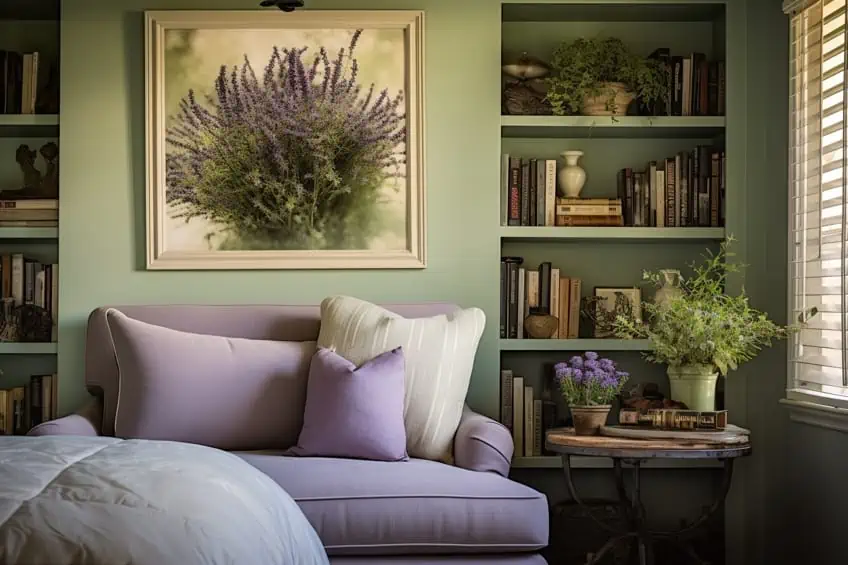
Sage Green and Copper Brown
Sage green paired with copper brown creates a warm and inviting color scheme with a touch of metallic elegance. Use Sage Green as the primary color for walls or larger pieces and incorporate Copper Brown through lighting fixtures, decor, and accent elements. Personal tip: Introduce natural textures like leather or wood to complement the warmth of the colors. This combination is excellent for creating a cozy and stylish ambiance in living rooms or dining areas.
| Shade | Hex Code | CMYK Color Code (%) | RGB Color Code | Color |
| Sage Green | #7BA05B | 37, 6, 58, 0 | 123, 160, 91 | |
| Copper Brown | #B87333 | 18, 47, 78, 28 | 184, 115, 51 |
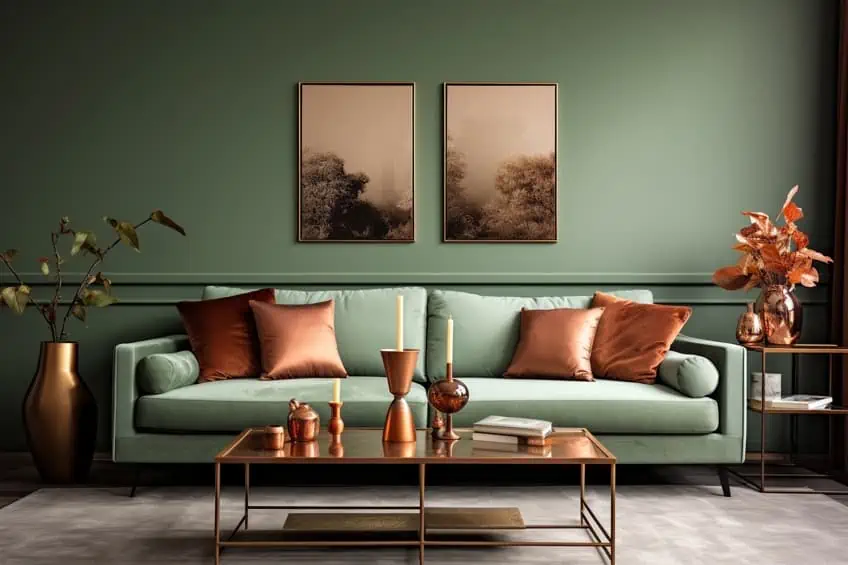
Sage Green and Gold
Pairing sage green with gold creates a luxurious and sophisticated color palette. Use Sage Green as the foundational color for walls or larger furnishings and incorporate Gold through accessories, lighting fixtures, and decor items. Personal tip: Use mirrors strategically to enhance the reflective qualities of gold and create a sense of opulence. This combination is ideal for creating a glamorous and elegant atmosphere in formal dining rooms or master bedrooms, adding a touch of timeless luxury to the space.
| Shade | Hex Code | CMYK Color Code (%) | RGB Color Code | Color |
| Sage Green | #B2AC88 | 0, 3, 24, 30 | 178, 172, 136 | |
| Gold | #FFD700 | 0, 16, 100, 0 | 255, 215, 0 |

Sage Green and Soft Gray
The combination of sage green and soft gray creates a serene and versatile color palette with a timeless appeal. Sage Green serves as a calming foundation, while Soft Gray adds a subtle sophistication. In interior design, consider using Sage Green for larger surfaces like walls or main furniture pieces, and incorporate Soft Gray through upholstery, textiles, and smaller decor items. Personal tip: Play with different shades of Soft Gray to create depth and interest within the space, avoiding a monotonous look. This color combination works exceptionally well in bedrooms and living rooms, offering a neutral backdrop that allows for easy incorporation of various styles and accents.
| Shade | Hex Code | CMYK Color Code (%) | RGB Color Code | Color |
| Sage Green | #7BA05B | 37, 6, 58, 0 | 123, 160, 91 | |
| Soft Gray | #A9A9A9 | 0, 0, 0, 40 | 169, 169, 169 |

Sage green is the perfect color to introduce to any room, especially considering the numerous colors that can successfully be combined with sage green. Go dramatic and contemporary by combining it with black or use dusty pink for a light and airy ambiance. Either way, incorporating a color like sage green that represents nature, wisdom, growth, and peace, is sure to make any occupant a happier human.
Frequently Asked Questions
What Are Colors That Go With Sage Green?
What are colors that go with sage green? Pink, orange, purple, yellow, and blue are among the colors that go with sage green, depending on the specific shade of sage green.
What Are Sage Green Complementary Colors?
What are sage green complementary colors? The complementary color of sage green sits directly opposite it on the color wheel. Depending on the exact shade of sage green, lavender usually results in its complementary color. The split complementary colors of sage green are lavender and dusty blue.
What Are Contrast Colors for Sage Green?
What are contrast colors for sage green? Because sage green is such a soft, natural color, you might want to add a few contrasting colors to your interior to add depth. Colors that contrast sage green are usually very dark and saturated colors, which include black, brown, terra cotta, and navy blue.
What Are Some Sage Green Color Combinations?
What are some sage green color combinations? Sage green looks great when combined with most earthy colors such as brown, beige, terra cotta, and black. Other colors that go with sage green are navy blue, mustard, and dusty pink.
Duncan graduated with a diploma in Film and TV production from CityVarsity in 2018, after which he continued pursuing film while taking on a keen interest in writing along the way. Since having graduated, he began working as a freelance videographer, filming a variety of music videos, fashion and short films, adverts, weddings and more. Throughout this, he’s won a number of awards from various film festivals that are both locally and internationally recognized. However, Duncan still enjoys writing articles in between his filming ventures, appreciating the peace and clarity that comes with it.
His articles focus primarily around helping up-and-coming artists explore the basics of certain colors, how these colors can be paired with other shades, as well as what colors are created when you mix one with another. All while relating these shades to historically significant paintings that have incorporated them into their color palette. As a lover of the arts himself, he takes great interest in the Renaissance era of paintings, an era that has directly inspired many of his favorite films.
Learn more about Duncan van der Merwe and about us.
